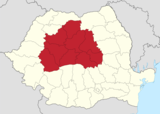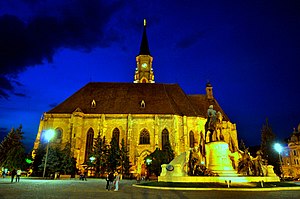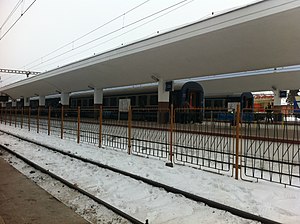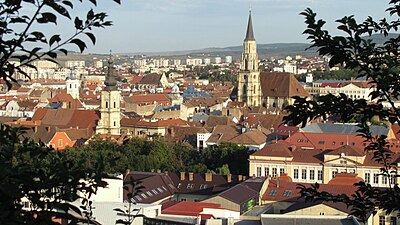
Transylvania is the largest region of Romania and probably the best known one. When you visit Transylvania you dive into a mix of cultures, nature and history. Transylvania is a diverse region: it is worth trying to observe the differences that exist within the region, both culturally and naturally. This region is a place with abundant history and multicultural convergence. All over Transylvania the cohabitation of Romanians, Hungarians, Saxons and Roma is the leading theme. Transylvania is rich in myth and misty medieval sites: there about 100 castles and fortresses and about 70 fortified churches. Romania's greatest and best preserved castles and fortresses are to be found here. But for the more curious traveler, there are many small villages with old houses and fortified churches. As Transylvania is circled by the Carpathian mountains there are a lot of mountain forests and hiking or climbing possibilities. All over the Carpathians there are great national parks. In the center of Transylvania there are green hills and rivers. Most big cities are very western Europe like, and the infrastructure is generally good, making it easy for travelers.
Regions
edit
| South-east (Sibiu County, Brașov County) This region, with Sibiu and Brașov, has a more pronounced Saxon (German) background. It is one of the most popular places for travelers due to its richness in fortresses (Rasnov, Bran, Rupea), old towns, fortified churches in picturesque villages (Biertan, Valea Vilor, Prejmer) and mountain forests (Piatra Craiului). It is also home to some of the most important ski resorts (Poiana Braşov). |
| East (Covasna County, Mureș County, Harghita County) The region around Sfântu Gheorghe, Miercurea Ciuc and Târgu-Mureş has strong Hungarian cultural influences. The counties Harghita (Miercurea Ciuc) and Covasna (Sfântu Gheorghe) are also known as the Szeklerland. Here you can buy fresh bread and Kürtőskalács from locals or see the Sfânta Ana lake. |
| South-west (Alba County, Hunedoara County) Hunedoara (Deva) and Alba (Alba Iulia) are important historical sites for Romanian culture. Alba Iulia was the place where the unification of the Romanian regions was decided. In this region you can see the great Corvinești Castle, lakes, caves and other beautiful natural sites. The main access points to Retezat National Park are to be found here. |
| North-west (Bistrița-Năsăud County, Cluj County) Cluj and Bistrița-Năsăud are harder to define in terms of a predominant culture. Cluj Napoca is a very important university and research city. It also has important historical and cultural landmarks. Around it there are picturesque villages (Romanian, Hungarian and German). Near Turda you can visit the imposing Turda Canyon. Bistrița-Năsăud is famous for its lakes, caves, health resorts, but also historical sites. |
Cities
edit
- 1 Aiud — an ancient city with a small, 14th-century citadel
- 2 Alba Iulia — home to a massive baroque fortification built in the 18th century, with a medieval Catholic cathedral
- 3 Brașov — a modern industrial city with a well-preserved Old Town
- 4 Cluj-Napoca — the biggest city in Transylvania, also called "The heart of Transylvania"
- 5 Sibiu — a compact city with German flair, medieval charm, excellent views of the surrounding landscapes, great food, and stunning parkland
- 6 Sighișoara — a small medieval fortified city, listed by UNESCO as a World Heritage Site
- 7 Sfântu Gheorghe — one of the oldest cities in Transylvania, it is a centre for the Hungarian-speaking people of the region
- 8 Târgu-Mureș — famous for its Art Nouveau buildings, Târgu Mureș is the cultural and economical centre of the Székely Land of the Hungarian minority
Other destinations
edit- 1 Râșnov — home to a restored Saxon fortress from the 14th century, and to many old Saxon houses
- 2 Apuseni Mountains —Huedin and surrounding villages, an agrotourism and ecotourism hotspot, as they offer wonderful scenery, secluded areas, great Romanian social and rural experiences
- 3 Păltiniș — the highest mountain resort in Romania
- 4 Retezat National Park — one of the most beautiful parks in Romania
- 5 Szeklerland — Târgu Secuiesc, Miercurea Ciuc, are home to the Szekler people, also known as Szekely, who are a Hungarian-speaking people of Transylvania
- 6 Turda — visit the former Salt mine, now a tourist attraction and amusement park
- 7 Lunca Ilvei — a remote mountain community, where you can experience farming, forestry and shepherding
Understand
editAlthough some people may only associate the name with tales of bloodthirsty vampires (it is the home of the title character in Bram Stoker's novel Dracula), Transylvania is one of the most beautiful natural regions in Europe, dotted with picturesque, medieval fortress towns and monasteries. Lively cities with stunning baroque architecture offer modern tourism services at a price far below that of, say, Germany or France. Here you can find some of the most developed cities in Romania, but also old villages where people live as they did a hundred years ago. Transylvania is surrounded by the misty Carpathian mountains and is home to rare fauna (bears, wolves) and flora (orchids and other plants).
Transylvania has all the history and multi-ethnic culture you could want. The history of Transylvania is much disputed: once it was an integral part of the Kingdom of Hungary (950-1526), then an independent Principality (1526-1690) before being reabsorbed by the Habsburg Empire. It was united with Wallachia and Moldovia to form Romania after the Austro-Hungarian Empire was dissolved in the Treaty of Trianon, which saw the conclusion of World War I. This complex history explains the many cultural differences between Transylvania and the rest of Romania. For much of this history the Romanian majority had few rights and were ruled by minorities such as the Hungarians and Saxons. Other minorities included Roma, Jews and Armenians. After World War I, Transylvania became part of Greater Romania, and many local Hungarians fled across the new border to Hungary. Following the defeat of the Axis powers in World War II, many of the local Germans fled to Germany. The Communist era was a harsh time for ethnic minorities, especially for those of whom many had been small business owners (Hungarians and those Jews who had survived the war) before the new totalitarian regime came to power. After the revolution in 1989, most of the remaining Saxons moved to Germany (having settled in Transylvania, at that time part of the Kingdom of Hungary, in large numbers during the 13th century), and many of the remaining ethnic Hungarians also left. The relations between the ethnic minorities and majority have known tense times, but there has never been a serious conflict. Although attitudes of individuals can still be closed towards other groups, Transylvania is an example of different ethnic groups living together in relative peace. However, as with Europe in general, the Roma ethnicity is still seriously discriminated against and their culture is little understood.
Today Transylvania is the most developed region in Romania, partly because of tourism and partly because of a stronger capitalist tradition prior to World War II. The presence of the German and Hungarian minorities has been a catalyst for Western influences in Transylvania since 1989. It is interesting to observe the differences within this small region: the South and South East are dominated by Saxon culture, the East and North East are more influenced by Hungarian culture, the North is more Slavic, and the South West different again. Try to visit a few older villages, where the people are generally very friendly.
Talk
editNowadays, almost everyone in Transylvania speaks Romanian, though for many of the ethnic Hungarians -- about 20% of the population, but far more in certain areas -- Hungarian is their first language. Few native German-speakers remain, but in any sizable town you should easily be able to find people who speak at least moderately good English, French, or German.
Get in
editTransylvania is relatively easy to access, due to its relative economic prosperity, tourism industry and proximity to Central Europe.
By plane
edit- 1 Cluj Avram Iancu International Airport (Aeroportul Internațional Avram Iancu Cluj CLJ IATA). Flights from Alicante, Barcelona, Basel/Mulhouse, Bologna, Dortmund, Eindhoven, Frankfurt-Hahn, Leeds/Bradford, Madrid, Malaga, Malmo, Nuremberg, Rome, Valencia, Zaragoza (provided by Wizz Air); Bucharest (TAROM and HiSky); Budapest (Aeroexpress Regional); Charleroi, Milan-Bergamo, Paris-Beauvais (provided by Ryanair and Wizz Air); Dublin (Ryanair and HiSky); Istanbul (Turkish Airlines); London (from Luton provided by Wizz Air and from Stansted provided by Ryanair); Munich (Air Dolomiti and from Memmingen provided by Wizz Air); Tel Aviv (Wizz Air and HiSky); Warsaw (LOT); Zurich (Swiss International Air Lines).
- 2 Sibiu International Airport (SBZ IATA) (6 km west of city centre on the main highway 1/7, with five bus routes picking up at the airport gate - route 11 (pink line) is best for the centre. A taxi to the centre will cost around 25 lei daytime, 30 lei late night). Flights from Dortmund, Karlsruhe/Baden Baden, London-Luton, Nuremberg (provided by Wizz Air); Munich (Lufthansa and from Memmingen by Wizz Air); Vienna (Austrian Airlines). There are no domestic flights. Small café & currency exchange, car hire desks.
By train
edit

There are several daily international trains:
- Dacia Express -links Vienna with Bucharest (via Budapest); it passes through various cities in the southern part of Transylvania (Deva, Alba Iulia, Mediaş, Sighisoara, Brasov);
- Ister Express -a faster night train that links Budapest with Bucharest and has the same route as above;
- Pannonia Express -links Prague with Bucharest (passing through Bratislava and Budapest) and reaches the same cities in southern Transylvania as the above trains;
- Corona Express -a night train that links Budapest with Brasov going through Cluj and the eastern parts of Transylvania;
- Hargita Express -links Budapest with Brasov going through Cluj-Napoca and the eastern parts of Transylvania (from Cluj-Napoca two coaches are going to Târgu-Mureş);
- Ady Endre Express -links Budapest with Cluj-Napoca (leaves from Cluj-Napoca early in the morning, gets to Budapest around noon and then gets back to Cluj-Napoca, arriving in the evening);
- Maros/Mureş Express -links Budapest with Târgu-Mureş;
- Máramaros/Maramureş Express -links Budapest with Sighetu Marmaţiei going through Cluj-Napoca (leaves from Budapest in the morning, gets to Sighetu Marmaţiei at evening, the schedule back to Budapest is the same.);
Very frequent trains link cities in Transylvania with Bucharest and major cities in all other regions of Romania. Check timetables on infofer.ro [dead link].
There are three kind of trains.
- Regio - This is the slowest but cheapest way to go somewhere. The Regio trains stop at every station.
- InterRegio - The InterRegio trains is much faster than the Regio. Due to the fact that it is very comfortable many international trains are InterRegio. The ticket is more expensive than the Regio ticket but affordable.
- InterCity - The fastest and the most comfortable way to travel but the ticket is very expensive.
The cheapest way to travel is the train even for four of you. On a few routes you can find private companies, they offer cheaper tickets.
Get around
editTransylvania is a must see destination for people travelling in this part of Europe.
Trains are usually the best way to travel between major Transylvanian cities and tourist destinations. However, many of the region's landmarks lie hidden from major transportation routes, so it is recommended you either rent a car or take buses to those places. You can find information about trains from infofer.ro[dead link] and Căile Ferate Române[dead link].
You can find great and detailed road maps in any fuel station throughout the country, in train stations and in most newsstands. These detailed road maps can lead you anywhere, without much guidance needed. Be careful though for secondary and tertiary roads are not clearly marked, so sometimes you have to ask for directions. People are usually very friendly and will help you get to the destination of your choice.
Buses are becoming a popular means of transportation in Transylvania. Usually, they leave from train stations in major cities, and stop in the central area of smaller ones.
As in all eastern Europe, hitchhiking is common and even a preferred way of transport for some locals. It is polite to leave the one who drives you some money, about 10-15 lei/100 km. However, people won't get mad if you don't leave anything and they might turn your money down anyway. Choosing the right spot for hitching increases your chances drastically- try to ask people on the street where to stand.
Bicycles are a very convenient and eco-friendly way of getting around in Transylvania and this way you can observe the natural beauty and even visit the smallest and remotest of villages. Beware though that most circuits include large elevations, so you should be used to climbing hills. In remote villages you can always find locals who will sell you very cheaply some fresh produce: fruits, vegetable, dairy products, or even invite you for lunch. Racing bikes with narrow tires are not recommended though, even major roads have many defects and in the more remote areas you will travel on dirt roads, so a robust mountain bike is preferred.
See
editDue to the salt and gold found under the ground, Transylvania was a rich country in the medieval age. Therefore can be found a lot of castles, fortresses (ruins) and beautiful towns. For those who love nature, Transylvania is a good choice. There are beautiful mountains, forests and even animals.
Transylvania has several UNESCO World Heritage sites; the Historic Centre of Sighişoara, the "Dacian Fortresses of the Orastie Mountains" consisting of eight fortresses in the southwest of Transsylvania, and the "Villages with Fortified Churches in Transylvania" consisting of over 150 sites.
Cities and towns
edit
In Transylvania you should see some cities or towns. Probably that most of the tourists are going to see Sighişoara the beautiful Saxon town (the people say that Dracula was born here). For those who like mountains the best choice is Braşov. There you can find a citadel, a beautiful church with history, large squares and mountains. Citadels can be found in other cities like Cluj-Napoca. At Cluj-Napoca you can find old churches, historical buildings, a citadel (with beautiful panorama), bastions, monuments (like the statue of Matthias Corvinus) and even Roman ruins.
Castles and fortresses
edit- Bran castle. It is in Bran, not far from Râşnov. It dates back to the 14th century and is often associated with Vlad Țepeș and Dracula. Even though the castle's architecture can evoke associations with blood-sucking monsters, there is hardly any proof that Vlad Țepeș ever visited it. Today the castle is a museum. Due to its reputation as "Dracula's castle", its exhibits deal with various aspects of folk beliefs, including vampires, and Vlad Țepeș. The texts that accompany the exhibits are written in Romanian and English. The entrance fee is overpriced at 25 lei for adults. Those with student ID card: can get in for 10 lei.
- Râşnov castle was built in the 13th century. The impressive complex with living houses (unusual for such fortresses) and small streets is located on a mountain in the outskirts of Râşnov. Transfer from the car park at the foot of the mountain to the castle and back is about 8 lei. But one can easily walk the way in 15 minutes. The entrance fee for adults is 10 lei.
Salt mines
editNature
edit

60% of all bears and 50% of wolves in Europe (except Russia) are found in Romania and the majority of them in Transylvania. Despite this it is still unlikely that you will see any.
Transylvania is located in a mountainous region and is surrounded by the Carpathian Mountains.
Do
edit- Bear watching, to spot the bears living in the region. There are several bear watching hides in Transylvania.
Buy
editEat
editRomanian dishes
edit- Sarmale - meat in grape or cabbage leaves
- Mici - a symbol of Romania. To some locals it is like the sword to a samurai (but tastier).
- Ciorba de Burta - tripe (cow stomach) soup. Tastes better than it sounds!
- Bulz - cheese with polenta (only in Transylvania).
- Papanasi - desert: try it, love it.
Hungarian dishes
edit- Bean soup in bread - you will be amazed from serving to licking your plate
- Gulash
- Cabbage soup
- Lentil soup
- Kurtos Kalacs - dessert, can be found around tourist attraction or in Hungarian zones on the road
Saxon dishes
editThere aren't many Saxon restaurants, but if you find one you can explore it and post some info here.
Drink
edit- Ursus Black beer – a medium-bodied, dark lager arguably ranking among Eastern Europe's premier drinks
- Bergenbier – a rich, German-style lager extremely popular throughout Romania
- Stejar beer – a 7% strong beer with a distinct taste
- Lacrima Lui Ovidiu – a nice, sweet Romanian wine, available in supermarkets for around 20 lei.
- Dracula Beer – a kitsch beer sold to foreign tourists, around Bran Castle and in supermarkets, noted for its remarkably unsavory flavor.
- Ciuc beer – one of the best beers part of the Group Heineken
- Wine from a local wine cellar – You will find these in any town, just ask for "crama" (krahmah)
- Horinca de Bihor, or other Țuică – This is a local brandy. Many locals brew their own natural and tasteful brandy. You can find it at locals' houses (they will be happy to have you taste theirs) and in wine cellars.
Sleep
editStay safe
editTransylvania is not a land of dangers lurking around each darkened corner. It houses a relatively large number of police headquarters, so that if anything goes wrong on your journey, help will be close by.
On the other hand, especially in heavily touristed towns like Sinaia, there will be some con men out to prey on tourists. Beware of the "maradona". You should also watch out for pickpockets around busy tourist attractions.
Police corruption has been reduced significantly and you would be better off being nice and friendly to police officers, rather than offering them money. If you feel like you are being mistreated by a police officer, ask for his superior.
Go next
edit- Maramureș in the north, Banat in the south west and Crișana in the west are historically tied to Transylvania and can be a good extension of your trip to Transylvania.
- Moldavia is popular for its monasteries and small villages.
- Dobrogea is where you can go to the Black sea coast.
- Bucharest is the capital of Romania and about 3 hours away from Brașov.
- In the south of Romania you can see the green Oltenia and the fieldy region of Muntenia.

